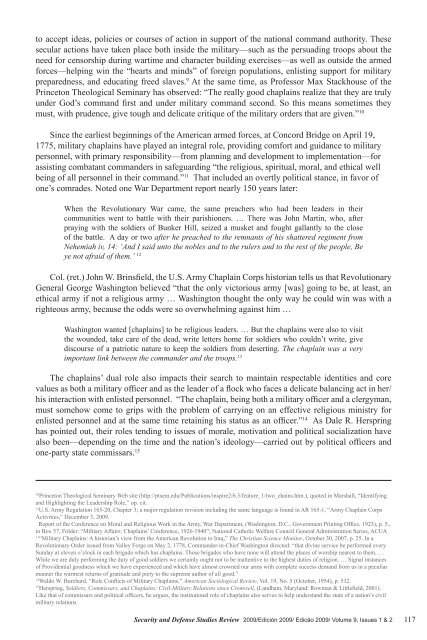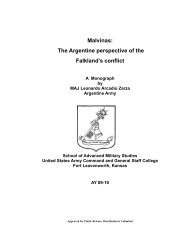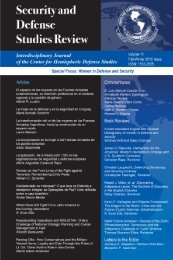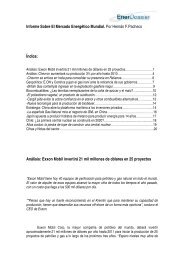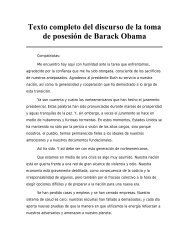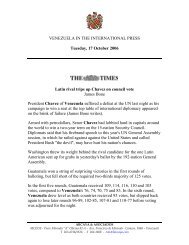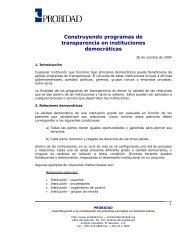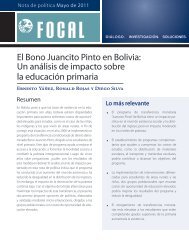Security and Defense Studies Review - Offnews.info
Security and Defense Studies Review - Offnews.info
Security and Defense Studies Review - Offnews.info
You also want an ePaper? Increase the reach of your titles
YUMPU automatically turns print PDFs into web optimized ePapers that Google loves.
to accept ideas, policies or courses of action in support of the national comm<strong>and</strong> authority. Thesesecular actions have taken place both inside the military—such as the persuading troops about theneed for censorship during wartime <strong>and</strong> character building exercises—as well as outside the armedforces—helping win the “hearts <strong>and</strong> minds” of foreign populations, enlisting support for militarypreparedness, <strong>and</strong> educating freed slaves. 9 At the same time, as Professor Max Stackhouse of thePrinceton Theological Seminary has observed: “The really good chaplains realize that they are trulyunder God’s comm<strong>and</strong> first <strong>and</strong> under military comm<strong>and</strong> second. So this means sometimes theymust, with prudence, give tough <strong>and</strong> delicate critique of the military orders that are given.” 10Since the earliest beginnings of the American armed forces, at Concord Bridge on April 19,1775, military chaplains have played an integral role, providing comfort <strong>and</strong> guidance to militarypersonnel, with primary responsibility—from planning <strong>and</strong> development to implementation—forassisting combatant comm<strong>and</strong>ers in safeguarding “the religious, spiritual, moral, <strong>and</strong> ethical wellbeing of all personnel in their comm<strong>and</strong>.” 11 That included an overtly political stance, in favor ofone’s comrades. Noted one War Department report nearly 150 years later:When the Revolutionary War came, the same preachers who had been leaders in theircommunities went to battle with their parishioners. … There was John Martin, who, afterpraying with the soldiers of Bunker Hill, seized a musket <strong>and</strong> fought gallantly to the closeof the battle. A day or two after he preached to the remnants of his shattered regiment fromNehemiah iv, 14: ‘And I said unto the nobles <strong>and</strong> to the rulers <strong>and</strong> to the rest of the people, Beye not afraid of them.’ 12Col. (ret.) John W. Brinsfield, the U.S. Army Chaplain Corps historian tells us that RevolutionaryGeneral George Washington believed “that the only victorious army [was] going to be, at least, anethical army if not a religious army … Washington thought the only way he could win was with arighteous army, because the odds were so overwhelming against him …Washington wanted [chaplains] to be religious leaders. … But the chaplains were also to visitthe wounded, take care of the dead, write letters home for soldiers who couldn’t write, givediscourse of a patriotic nature to keep the soldiers from deserting. The chaplain was a veryimportant link between the comm<strong>and</strong>er <strong>and</strong> the troops. 13The chaplains’ dual role also impacts their search to maintain respectable identities <strong>and</strong> corevalues as both a military officer <strong>and</strong> as the leader of a flock who faces a delicate balancing act in her/his interaction with enlisted personnel. “The chaplain, being both a military officer <strong>and</strong> a clergyman,must somehow come to grips with the problem of carrying on an effective religious ministry forenlisted personnel <strong>and</strong> at the same time retaining his status as an officer.” 14 As Dale R. Herspringhas pointed out, their roles tending to issues of morale, motivation <strong>and</strong> political socialization havealso been—depending on the time <strong>and</strong> the nation’s ideology—carried out by political officers <strong>and</strong>one-party state commissars. 1510Princeton Theological Seminary Web site (http://ptsem.edu/Publications/inspire2/6.3/feature_1/two_chains.htm.), quoted in Marshall, “Identifying<strong>and</strong> Highlighting the Leadership Role,” op. cit.11U.S. Army Regulation 165-20, Chapter 3; a major regulation revision including the same language is found in AR 165-1, “Army Chaplain CorpsActivities,” December 3, 2009.Report of the Conference on Moral <strong>and</strong> Religious Work in the Army, War Department, (Washington, D.C., Government Printing Office, 1923), p. 5.,in Box 57, Folder: “Military Affairs: Chaplains’ Conference, 1926-1940”; National Catholic Welfare Council General Administration Series, ACUA13“Military Chaplains: A historian’s view from the American Revolution to Iraq,” The Christian Science Monitor, October 30, 2007, p. 25. In aRevolutionary Order issued from Valley Forge on May 2, 1778, Comm<strong>and</strong>er-in-Chief Washington directed: “that divine service be performed everySunday at eleven o’clock in each brigade which has chaplains. Those brigades who have none will attend the places of worship nearest to them. …While we are duly performing the duty of good soldiers we certainly ought not to be inattentive to the highest duties of religion. … Signal instancesof Providential goodness which we have experienced <strong>and</strong> which have almost crowned our arms with complete success dem<strong>and</strong> from us in a peculiarmanner the warmest returns of gratitude <strong>and</strong> piety to the supreme author of all good.”14Waldo W. Burchard, “Role Conflicts of Military Chaplains,” American Sociological <strong>Review</strong>, Vol. 19, No. 5 (October, 1954), p. 532.15Herspring, Soldiers, Commissars, <strong>and</strong> Chaplains: Civil-Military Relations since Cromwell, (L<strong>and</strong>ham, Maryl<strong>and</strong>: Rowman & Littlefield, 2001).Like that of commissars <strong>and</strong> political officers, he argues, the institutional role of chaplains also serves to help underst<strong>and</strong> the state of a nation’s civilmilitary relations.<strong>Security</strong> <strong>and</strong> <strong>Defense</strong> <strong>Studies</strong> <strong>Review</strong> 2009/Edición 2009/ Edicão 2009/ Volume 9, Issues 1 & 2 117


